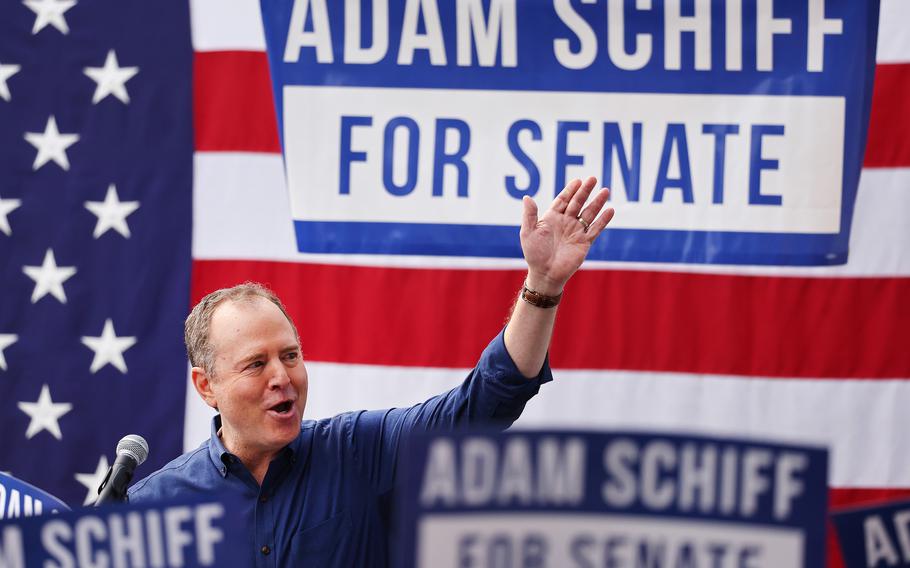
Rep. Adam Schiff (D-Calif.) waves to supporters outside the International Alliance of Theatrical Stage Employees Union Hall, at the campaign kickoff rally on Feb. 11, 2023, in Burbank, Calif. (Mario Tama, Getty Images/TNS)
(Tribune News Service) — Rep. Adam Schiff got what he paid for. As expected, the California Democrat won first place in the state’s top-two primary for the U.S. Senate on Super Tuesday. And just as Schiff wanted, former Major League Baseball player Steve Garvey, a Republican, came in second.
As in Louisiana and Washington (Alaska has its own variation), California candidates run for office in a multi-partisan primary. The top two vote-getters, regardless of party, move on to the general election. The idea, when the top-two primary was adopted statewide in 2010, was to create a moderating force, pushing candidates toward the broad middle of the electorate. It was meant to discourage candidates from appealing to the most adamant partisans to win a primary.
It seemed like a good idea at the time. But it also seems indicative of reforms meant to insulate elections from problems that fester less in the mechanics of the electoral system and more inside the parties and American political culture.
The top-two system can only do so much in California in part because the California Republican Party is too unpopular to mount credible statewide campaigns. Statewide elections are mostly Democrat-on-Democrat combat, often, as in this year’s Senate contest, with a side of Democrat-inspired intrigue.
Schiff has been accused, correctly, of trying to pick his opponent. He and his allies spent millions on ads designed to turn out Republican support for Garvey in order to block Schiff’s more serious rival, fellow Democratic Rep. Katie Porter, from reaching the November general election. Schiff and friends appear to have spent more money supporting Garvey than Garvey spent supporting Garvey. (Porter, who proved to be a shockingly intemperate sore loser, had supported a different Republican in an effort to cut into Garvey’s vote total.)
“Attempting to choose your opponent is not new, and not limited to Top 2 systems,” said David Karol, a University of Maryland political scientist. Indeed, a political action committee aligned with Senate Majority Leader Chuck Schumer launched an ad campaign in Ohio in an effort to assist a Trumpy Republican in the GOP Senate primary there. (The ad asserts that candidate Bernie Moreno is “too conservative for Ohio,” thereby seeking to trigger MAGA voters’ Pavlovian urge to own the libs by voting for the candidate most likely to vex liberals.)
Such machinations are inevitable. In a highly polarized nation, where one party has departed from democratic norms and values and the other is desperately clinging to them, where policies on everything from taxes to personal liberty are starkly divergent, the high stakes lead candidates, and parties, to maximize any advantage they can find.
Studies have reached diverse conclusions about whether the top-two system has had a moderating effect on political outcomes. In many cases, however, it’s worth asking whether the system has any effect at all. California’s November general election ballot is probably no different than if there had been separate partisan primaries producing two partisan candidates. (Although it’s possible that a partisan primary would have attracted more GOP candidates.) It’s not a new phenomenon.
“In 2022,” said Thad Kousser, a political scientist at the University of California, San Diego, “every partisan state constitutional office featured a race between a Democrat and Republican, races that looked much like the pre-top-two system.”
The 2016 Senate election did feature two Democrats. But there was little ideological or practical difference between center-left Democrat Kamala Harris and center-left Democrat Loretta Sanchez. Conservative voters certainly didn’t seem to feel that they had anyone to cheer for.
Ultimately, the top-two primary seems like a reform that didn’t reform much, polarization very much included. That’s because the problem isn’t that closed-party primaries heighten polarization. As political scientists Seth Masket and Hans Noel point out, “one of the least polarized periods in congressional history was in the 1950s and ’60s, when primaries were widely in effect.”
There is no way to tinker with election mechanics and recapture the bipartisan behavior of Washington in the era just prior to landmark civil rights legislation and the 1965 immigration reform, two catalysts of political polarization. The 21st century Republican Party has not become an anti-science, pro-insurrection and increasingly pro-Russia institution because party primaries are vectors of radicalization. A party that wallows in propaganda and paranoia is unlikely to produce responsible, democracy-promoting candidates regardless of the system for choosing them.
Parties provide the organizing, and animating, logic for American politics, thrashing out policies and political agendas for millions of like-minded supporters. They also draw on deep draughts of identity, ambition, myth and fear. A top-two primary might sometimes be able to adjust the sails on a ship gently veering off course. But it can’t slay the monsters lurking beneath the waves.
Francis Wilkinson is a Bloomberg Opinion columnist covering U.S. politics and policy. Previously, he was executive editor for The Week and a writer for Rolling Stone. This column does not necessarily reflect the opinion of the editorial board or Bloomberg LP and its owners.
©2024 Bloomberg L.P.
Visit bloomberg.com/opinion.
Distributed by Tribune Content Agency, LLC.